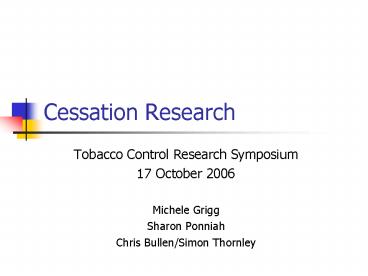Cessation Research - PowerPoint PPT Presentation
1 / 28
Title:
Cessation Research
Description:
Progress in research of relevance to Maori, inequalities, and Pacific people? ... STOMP, Smoking IQ (PQNIQ, SONIQ, RELIQ), STOMP 2, NEWS. School of Population Health ... – PowerPoint PPT presentation
Number of Views:67
Avg rating:3.0/5.0
Title: Cessation Research
1
Cessation Research
- Tobacco Control Research Symposium
- 17 October 2006
- Michele Grigg
- Sharon Ponniah
- Chris Bullen/Simon Thornley
2
Reviewing progress
- Progress in research of relevance to Maori,
inequalities, and Pacific people? - Areas no longer relevant?
- Any emerging research gaps/needs?
3
Where is cessation?
- Surveillance of Maori cessation rates (p26)
- Surveillance of Pacific peoples cessation rates
(p26) - Effectiveness of cessation programmes (p27)
4
Progress in cessation research
- HRC-funded research 05/06 and 06/07 rounds
future rounds? - NHF and CanSoc funded research
- MoH tobacco monitoring and surveillance programme
- Quitline programme evaluation
5
Examples of work underway
- MoH tobacco use survey Sharon Ponniah
- Auckland University projects Chris Bullen/Simon
Thornley
6
(No Transcript)
7
New Zealand Tobacco Use Survey
- Sharon Ponniah (Project manager)
8
NZTUS 2006 ? 2009
- CAPI data collection
- New Zealand population (15-64 years)
- Objectives
- Provide a measure for the prevalence of smoking
annually, - Collect valid and reliable measures of tobacco
use including consumption, initiation, addiction,
quitting, relapse and exposure to second-hand
smoke, - Collect comprehensive measures of, knowledge,
attitudes and beliefs about tobacco smoking and
control, - Provide reliable measures for populations of
interest NZ Maori, Pacific people, Asians and
15-19 year olds, - Monitor changes in tobacco use, quitting
behaviour, and attitudes and beliefs about
tobacco over time.
9
Modules
- Adult component (20) /youth component (15-19)
- Modules prevalence, smoking history,
consumption, intensity, addiction, quitting,
attitudes, pregnancy (youth specific) - Cessation component is core, with approx 30
questions - quit attempts, quitting advice and quitting aids
- Examples of questions
- In the last 5 years, have you tried to quit
smoking? - The last time you attempted to quit, did you
receive any help or advice on how to quit from a
health worker or a stop-smoking programme?
10
Sampling
- Stratified, clustered sampling
- Main sample and Screened sample
- Interviewing over three month period
- Allows collection of trends over time
- In 2006 NZTUS
- 500 meshblocks 5,782 completed interviews
- Response rate 75.39 (10)
- Smokers n 1606 non-smokers 4176
- Maori n 1087 Pacific 582 Asian 700 and
Euro/Other 3413
11
Further Information
- National Research Bureau (NRB) is contracted to
collect NZTUS data - Key prevalence estimates due to be released in
Tobacco Facts, October 31st 2006 - NZTUS 2006 report due for release in March 2007
- http//www.moh.govt.nz/phi/surveys/tus
12
(No Transcript)
13
Trials and Tribulations of Smoking Cessation
Research CTRU Experience
- Chris Bullen, Simon Thornley
14
Clinical Trials Research Unit
- Improving health through innovative research
- Programme of cessation research
- STOMP, Smoking IQ (PQNIQ, SONIQ, RELIQ), STOMP 2,
NEWS
School of Population Health
15
Nicotine Replacement Therapy
- Dominant pharmacotherapy for smoking
- Efficacy of active NRT over placebo
well-established - Absolute quit rates are low (10-30) and
effectiveness in practice as low as 7 at 6
months - How can the effectiveness of existing nicotine
replacement therapies be enhanced?
16
PQNIQ
- Single blind, randomised controlled trial,
comparing smokers taking NRT (patches or gum) for
2 weeks prior to the Quit day, with those
starting NRT as per usual practice - Participants
- Otherwise healthy smokers gt10 cigarettes/day
- Intervention
- NRT 2 weeks prior to quit day cf. usual practice
- Outcome
- quit at six months
17
(No Transcript)
18
SONIQ
- A randomised trial of increasing choice of
nicotine replacement therapies - Current practice based around use of one form of
NRT, usually patch - Does increased access and choice of NRT delivery
method improve quit rates? - Participants - Otherwise healthy relapsed
smokers gt10 cigarettes/day - Intervention
- Outcome - quit at six months
19
NEWS
- Niconovum Evaluation of Withdrawal relief Study
- A single blind, randomised, cross-over trial of
three novel NRTs (NicoNovum pouch, mouth spray
and lozenge) on the relief of tobacco withdrawal
symptoms
20
Niconovum products
21
Design
Drug admin.
Withdrawal Scales
Baseline W After O/N abst.
Ad lib NRT use
Evening CO test WD scale over day/hour Last day -
compare drugs
CO after cigarette Rate cigarette
22
Where to from here?
- NRT studies currently available NRT, new NRT
products, slow cessation - Novel methods of recruitment (e.g. Quitline) and
verification (Nicalert, voice) - Specific groups e.g. COPD
- New pharmacotherapies - Varenicline, Cytisine
23
Acknowledgements
- Health Research Council
- National Heart Foundation
- The Quit Group
- Niconovum
24
(No Transcript)
25
Cessation research gaps?
- Gaining knowledge from overseas and applying to
NZ - New ways of using nicotine replacement therapies
- Removing barriers to accessing effective
pharmacotherapies - New pharmacotherapies
- But need to assess applicability and relevance
for NZ, especially for ethnic groups, eg Maori
26
Cessation research gaps?
- Quitting behaviours resulting from other tobacco
control initiatives. What are the effects of
other initiatives? - Coordination required.
- Youth cessation any progress on what works?
27
A cessation strategy?
- To identify cessation research priorities
- To give direction to the sector
- To identify programmes and services required
- To assist with linkages and coordination
- For workforce development
- Using the revised Cessation Guidelines as a
starting point.
28
Cessation Research
- Tobacco Control Research Symposium
- 17 October 2006
- Michele Grigg
- Sharon Ponniah
- Chris Bullen/Simon Thornley































